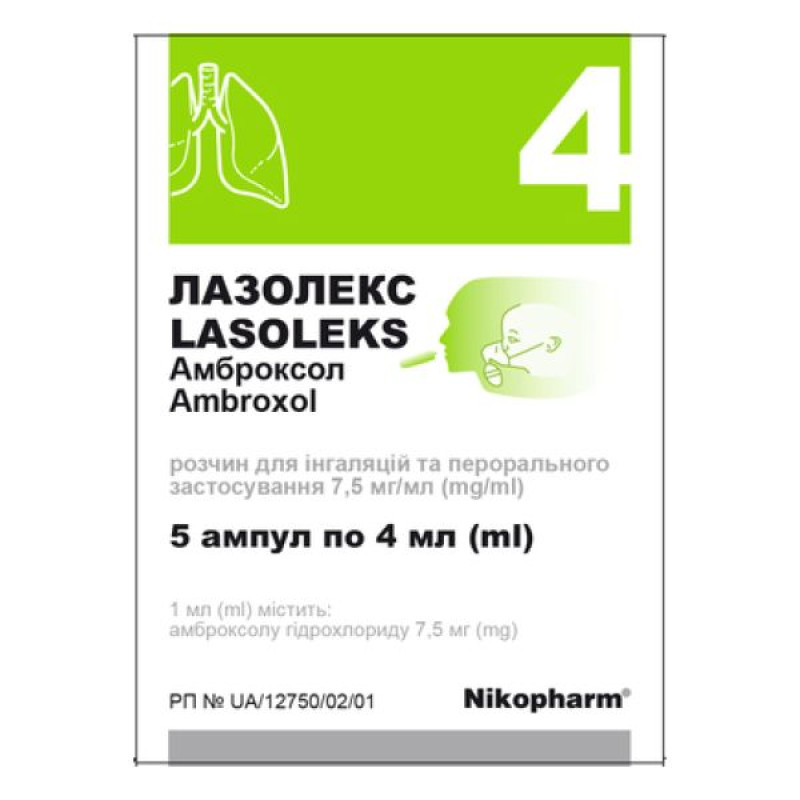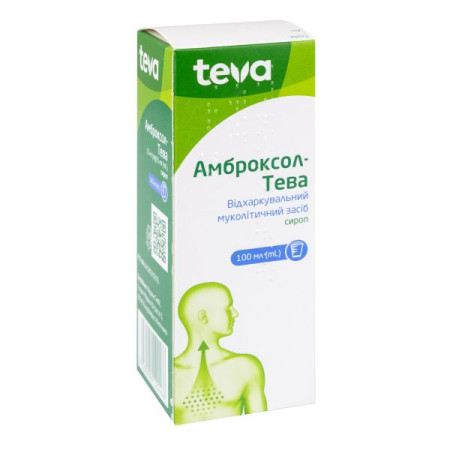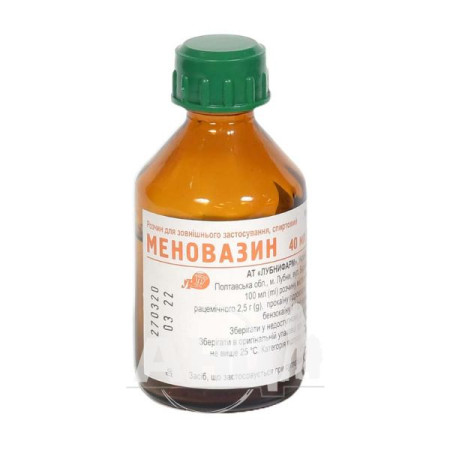Lazolex solution for inhalation and oral administration 7.5 mg/ml ampoules 4 ml No. 5

Instructions for use Lazoleks solution for inhalation and oral administration 7.5 mg/ml ampoules 4 ml No. 5
Composition
active ingredient: ambroxol hydrochloride;
1 ml of the drug contains 7.5 mg of ambroxol hydrochloride;
Excipients: sodium chloride, citric acid monohydrate, disodium phosphate dodecahydrate, water for injections.
Dosage form
Solution for inhalation and oral use.
Main physicochemical properties: clear, colorless or slightly brown solution.
Pharmacotherapeutic group
Medicines used for coughs and colds. Mucolytics.
ATX code R05C B06.
Pharmacological properties
Pharmacodynamics.
The active substance of ambroxol hydrochloride is a substituted benzylamine, a metabolite of bromhexine. It differs from bromhexine by the absence of a methyl group and the presence of a hydroxyl group in the para-trans position of the cyclohexyl ring.
As a result of the research, the secretolytic and secretomotor effect of ambroxol hydrochloride in the bronchial tract has been proven.
When taken orally, the effect occurs on average after 30 minutes and lasts 6-12 hours, depending on the individual dose.
Preclinical studies have shown that ambroxol hydrochloride increases the proportion of serous component of bronchial secretions. Ambroxol enhances mucus clearance by reducing viscosity and activating the ciliary epithelium.
Ambroxol activates the surfactant system by directly acting on Clara cells in the small airways and type II pneumocytes in the alveoli. It enhances the production and release of surfactant in the alveoli and bronchial tree of the fetus and adult. These effects have been demonstrated in various species in cell cultures and in vivo.
In addition, the antioxidant effects of ambroxol have been demonstrated in various preclinical trials.
Pharmacokinetics.
Absorption: Ambroxol is almost completely absorbed after oral administration. Tmax after oral administration is 1–3 hours. The absolute bioavailability of ambroxol when administered orally is reduced by approximately 1/3 due to presystemic metabolism.
Distribution. About 85% (80–90%) of the drug is bound to plasma proteins. In lung tissue, ambroxol reaches higher concentrations than in plasma when administered parenterally. Ambroxol can penetrate into the cerebrospinal fluid, through the placental barrier and into breast milk.
Metabolism: The formation of metabolites capable of penetrating the kidneys (e.g., dibromantranilic acid, glucuronide) occurs in the liver.
Elimination. Almost 90% of the drug is excreted by the kidneys in the form of metabolites formed in the liver. Less than 10% of ambroxol is excreted by the kidneys unchanged. Due to the high degree of binding to blood proteins, a large volume of distribution and slow redistribution of the drug from tissues to the blood during dialysis or forced diuresis, significant elimination of ambroxol is unlikely.
The terminal plasma half-life is 7–12 hours. The plasma half-life of ambroxol and its metabolites is approximately 22 hours.
Pharmacokinetics in certain patient groups.
In patients with severe liver disorders, the clearance of ambroxol is reduced by 20–40%. In patients with severe renal impairment, accumulation of ambroxol metabolites may occur.
Indication
Secretolytic therapy for acute and chronic bronchopulmonary diseases associated with impaired bronchial secretion and impaired mucus movement.
Contraindication
Lazolex, solution for inhalation and oral administration, should not be used in patients with hypersensitivity to ambroxol hydrochloride or other components of the drug.
Interaction with other medicinal products and other types of interactions
The simultaneous use of ambroxol and cough suppressants may lead to excessive mucus accumulation due to suppression of the cough reflex. Therefore, such a combination is possible only after a careful assessment by the doctor of the ratio of the expected and possible risks of use.
Concomitant use of ambroxol and antibiotics (amoxicillin, cefuroxime, doxycycline, and erythromycin) leads to higher concentrations of antibiotics in bronchopulmonary secretions and sputum.
Application features
Severe skin reactions: erythema multiforme, Stevens-Johnson syndrome/toxic epidermal necrolysis and acute generalised exanthematous pustulosis have been reported in association with the use of ambroxol hydrochloride. If signs of progression of the skin rash (sometimes associated with blistering or mucosal lesions) are present, ambroxol hydrochloride treatment should be discontinued immediately and medical advice should be sought.
Patients with impaired renal function or severe hepatic insufficiency should take ambroxol only after consulting a doctor. When using ambroxol, as with any active substance that is metabolized in the liver and then excreted by the kidneys, there is an accumulation of metabolites that are formed in the liver in patients with severe renal insufficiency.
Lazolex, solution for inhalation and oral administration, contains 40.96 mg of sodium per recommended daily dose. This should be taken into consideration by patients on a controlled sodium diet.
Use during pregnancy or breastfeeding
Pregnancy. Ambroxol crosses the placental barrier. Clinical studies of the use of the drug after the 28th week of pregnancy have not revealed any harmful effects on the fetus and the course of pregnancy. Animal studies have not revealed direct or indirect harmful effects on the course of pregnancy, embryonal/fetal development, childbirth or postnatal development. However, the usual precautions for use during pregnancy should be observed. Ambroxol is not recommended, especially in the first trimester of pregnancy.
Breastfeeding. Ambroxol passes into breast milk. Ambroxol should not be administered to women during breastfeeding.
Fertility: Preclinical studies do not indicate direct or indirect harmful effects with respect to fertility.
Ability to influence reaction speed when driving vehicles or other mechanisms
There are no data on the effect on the reaction rate when driving vehicles or working with other mechanisms. Studies on the effect on the reaction rate when driving vehicles or working with other mechanisms have not been conducted.
Method of administration and doses
Inhalation solution
Adults and children over 6 years of age: 1–2 inhalations of 2–3 ml of solution per day.
Children under 6 years of age: 1–2 inhalations of 2 ml of solution per day.
The drug Lazoleks, a solution for inhalation, can be used in all modern inhalation devices (except steam inhalers).
After opening the ampoule - the contents of the ampoule should be used immediately after opening; any unused solution should be discarded.
The drug Lazoleks, a solution for inhalation, should be diluted in a 1:1 ratio with saline to ensure optimal humidification of the air released by the device.
Lazoleks, solution for inhalation, should not be mixed with cromoglycic acid. It should also not be mixed with other solutions with a pH greater than 6.3, such as alkaline inhalation salt (Emser Salt). Due to the increase in pH, the ability of the free base of ambroxol hydrochloride to precipitate or the solution to become cloudy may increase.
It is usually recommended to warm the inhalation solution to body temperature before starting inhalation.
If only one inhalation per day is possible, Lazolex for oral administration should be used additionally.
Given that the inhalation process itself can provoke coughing, patients are advised to breathe normally during inhalation.
Patients with bronchial asthma should use bronchospasmolytics to open the lungs before inhalation.
Oral solution
Adults and children over 12 years of age: 4 ml 3 times a day for the first 2–3 days, which is equal to 90 mg of ambroxol per day, then 2 ml 3 times a day, which is equal to 45 mg of ambroxol per day.
The dosage of 4 ml 3 times a day may be continued after consultation with a doctor;
children aged 6–12 years: 2 ml 2–3 times a day, which is equal to 30–45 mg of ambroxol per day;
children aged 2 to 6 years: 1 ml 3 times a day, which is equal to 22.5 mg of ambroxol per day;
children under 2 years of age: 1 ml 2 times a day, which is equal to 15 mg of ambroxol per day.
Dosage for patients with renal and/or hepatic impairment
Patients with severe renal impairment or severe hepatic impairment should use the drug only after consulting a doctor, as it may be necessary to reduce the maintenance dose or extend the interval between administrations of the drug.
The drug Lazoleks, solution for inhalation and oral administration, should not be used for longer than 4–5 days without consulting a doctor.
In acute illnesses, you should consult a doctor if symptoms persist or worsen despite taking Lazolex.
The drug Lazoleks, a solution for oral administration, can be diluted in water, tea, fruit juice, milk. The drug Lazoleks can be taken regardless of meals.
The secretolytic effect of the drug Lazoleks is maintained provided that a sufficient amount of fluid enters the body.
Children.
The drug can be used in children. Children under 2 years of age should use the drug only as prescribed by a doctor.
Overdose
There are currently no reports of overdose with ambroxol. The symptoms known from isolated reports of overdose and/or cases of medication errors correspond to the known side effects of ambroxol at recommended doses and require symptomatic treatment.
Adverse reactions
Immune system disorders: Rare: hypersensitivity reactions; Not known: anaphylactic reactions, including anaphylactic shock, angioedema and pruritus.
Skin and subcutaneous tissue disorders: rare - rash, urticaria; not known - serious skin adverse reactions (including erythema multiforme, Stevens-Johnson syndrome/toxic epidermal necrolysis and acute generalized exanthematous pustulosis).
From the nervous system: often - dysgeusia (changes in taste sensations).
From the gastrointestinal tract: often - nausea, decreased sensitivity in the oral cavity; infrequently - vomiting, diarrhea, dyspepsia, abdominal pain, dry mouth; rarely - dry throat; very rarely - drooling.
Respiratory, thoracic and mediastinal disorders: Common: decreased sensitivity in the pharynx; very rare: dyspnoea and bronchospasm; unknown: dyspnoea (as a symptom of a hypersensitivity reaction).
General disorders: infrequently - fever, mucous membrane reactions.
Reporting of suspected adverse reactions
Reporting adverse reactions after the registration of a medicinal product is important. This allows monitoring of the benefit/risk ratio of the medicinal product. Medical and pharmaceutical professionals, as well as patients or their legal representatives, should report all cases of suspected adverse reactions and lack of efficacy of the medicinal product via the Automated Information System for Pharmacovigilance at the following link: https://aisf.dec.gov.ua
Shelf life: 2 years.
Storage conditions
Store in the original packaging at a temperature not exceeding 25 ºС.
Keep out of reach of children.
Packaging
1 ml or 2 ml or 4 ml in an ampoule. 5 ampoules in a cardboard pack.
Release category: Over-the-counter.
Manufacturer: LLC "PHARMASEL".
Location of the manufacturer and address of its place of business
Ukraine, 07408, Kyiv region, Brovarskyi district, Kvitneve village, Prorizna st., 3.
There are no reviews for this product.
There are no reviews for this product, be the first to leave your review.
No questions about this product, be the first and ask your question.





